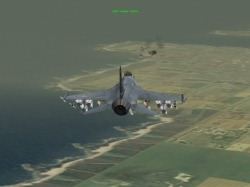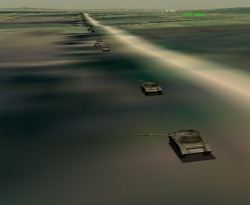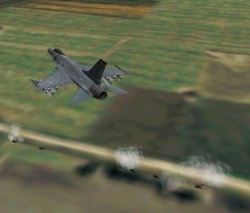| Falcon 4.0: Force on Force by Glenn "Sleepdoc" Kletzky, MD |
||||
|
"Sleepdoc" welcomes your input and response. You can mail him at the link above. If you missed parts 1 & 2 click HERE. In this, the third part of the Klemmick interview, we discuss the "Force on Force" multiplayer option (term copyrighted by Jeff "Rhino" Babineau, 1999, patent pending) of the TE mission builder. It is, as of yet, mostly undiscovered. I believe this to be true for a couple of reasons. The main reason, I believe, is because the ground war mission interface of TE is badly broken, and the bugs relating to it are essentially insurmountable. I tinkered with it for hours, and performed experiments with it, which clearly proved this to me. And even if it were not broken, I believe that it is the natural progression of a product such as this, that the users will discover these deeper features later. Most guys are still learning the more basic elements of the game. But, as with any game, time passes, we get better, and we start delving deeper into these features. Together with Jeff "Rhino" Babineau of the 209th Deltahawks, and our own Eric "Snacko" Marlow of the 303rd Sidewinders (Remember him? He's the guy with the great articles on F-15 tactics), we spent hours screwing around with the ground war element of the game. As a real tank battalion staff officer, Tank Company XO, and tank platoon leader during his military career, "Rhino" was greatly interested in this feature. As a guy who loves competitive, multiplayer strategy games (I was hooked on Battlezone for longer than I should admit to the hardcore sim crowd), I too found this element very exciting. We were hell bent together for a couple of nights trying to understand how it really worked. What we discovered is that the ground war element of TE is a mess. Don't even try it. You will be essentially wasting your time. It isn't even documented correctly as it stands now, and it will make you lose your mind as you try to add moving ground war elements to your missions. Yes, you can do it, and yes, sometimes they will go where they are told. But ultimately, the ground forces will incorrectly start pulling from the Campaign AI engine (which they are not supposed to do in TE, you are supposed to be the AI), and they will start re-issuing themselves orders which you have no control over. Further more, in the context of a TE mission you just designed, those new orders will only confirm to you that the AI battalion commander is suffering from a combination of severe Schizophrenia and late stage Alzheimer's. Suffice it to say, it is as broken as broken can get. But don't despair my ground war friends. Kevin Klemmick assures me that the fixes will be forthcoming soon. He said we would probably see some significant repairs in this next one or two patches, and those should make the dream take form very nicely. He even went further to say that the commitment to the TE mission builder was very high in the company, because most people believe it is this module alone which will give the series its greatest longevity and replayability. So Kevin chose to reveal to me the actual way the ground war element will work in the near future (and he was very confident that those bugs are repairable). In order to better understand the function, we must place it in the context of an example. The actual interface specifics of controlling the ground war will be spelled out in detail in my next article. This article, however, is designed to explain (as Kevin explained it to me), how the concept of the "Force on Force" multiplayer option will play out. In order to truly realize the full nature of the ground war feature, we must choose an example which uses all its features. Lucky for Mr. Babineau and myself, that example is the arrangement which we find the most compelling: the "Force on Force" multiplayer game. All that we discuss here also applies to the more limited "one shot mission" types like the ones we have been seeing a lot of lately on the net. My "Sleepdoc's situation" mission and the one I work you through in my mission builder article all fall in the "one shot mission" category. In a "Force on Force" Multiplayer mission, a template is created rather than an actual mission. Here is what I mean by that. In the "one shot" type mission, the designer/editor of the mission sets up specific flights and packages (and soon ground war movements complete with battalion objectives) for both sides of the game. The player who downloads the "one shot" type mission then plays it out. He jumps into the F-16 flight of his choice (for either side, so long as that side has pre-designated flights which include F-16s), and flies the missions that the designer created for him. |
He gets jumped or intercepted by whatever defending flights the mission designer built in. One way or the other, he flies the missions in the allotted time in order to attempt to achieve the "victory conditions" set forth by the original designer. Eventually, even if the mission had many flight opportunities for the flyer, the allotted missions run out, and the victory conditions are either achieved or not. Game over. Granted, some "one shot" mission types include a few, simple packages and are determined by a few, simple victory conditions. Other, more complex "one shot" type missions include tons of flying opportunities and a complex set of victory conditions which must be met as you fly flight after flight. However, both these types of "one shot" missions have a common element which allow me to group them both as the "one shot" type. And that is that YOU did not design the missions, and that YOU did not issue the orders to your ground troops. You had absolutely nothing to do with the strategy for winning the mission. Much like in the Campaign mode, you are nothing more than a grunt in this man's war, and you do as your told. You don't determine the makeup of the packages or the movement of the ground elements. You simply choose from the missions set forth to you by the Brass, and do your duty as a soldier, all the time having faith that the Big Brass have made the correct decisions for you. This describes the essence of what I term the "one shot" mission type. Not so in the "Force on Force" type multiplayer game. Remember I said that these missions consist of a "template" and no actual missions? This is what I mean. When you start a "Force on Force" type multiplayer mission, you will NOT SEE A SINGLE FLIGHT for you to fly. What you will see, however, are a series of resources for you to pull from, so that you (you are the Brass and the flyboy here) can design your own flights, packages and battalion moves. You tell the ground forces where to go and what to do when they get there. In fact, you could sit at the game interface for the entire time of the game, and never once fly. You could simply give orders to ground units and design packages to fly, and let the AI do the rest. You could play the entire war without once ever entering the actual 3d world. That's kind of silly, because we are flight sim fanatics, but you could do it. You could just sit there (knowing all along what the conditions for victory are) and read all the news updates and watch the Intel reports (which appear as enemy icons on the map) and move your pieces around like chess pieces. And if your planes get shot down, or your tanks get destroyed, you have lost that "resource" for the remainder of the match. PLANES AND TANKS etc. ARE NOT RENEWABLE THROUGHOUT THE COURSE OF A TE MISSION !!! You get what you get, and that is ALL you get. So one means of beating your compadre could be through winning the war of attrition, but if in the process of winning the war of attrition, you neglect to achieve the victory conditions set forth by the designer of the mission, then you have no bragging rights. It's a stalemate. (Where is Henry Kissinger when you really need him ?!?!?!) A typical "Force on Force" multiplayer game would progress as follows (much like a game of chess, only with louder explosions). Each player of a team (and you can have up 7 teams with their own starting territories) will have a specific amount of starting resources. In order to keep our example basic, this game will have 2 teams and each team will have 10 tank battalions, 10 mobile SAM battalions, 1 F-16 squadron, 1 F-15 squadron (Mig-29 for the enemy side) and 1 F-14 squadron (SU-27 for the enemy side). They will all be placed at starting locations around the map within their respective friendly territories. Furthermore, a fairly complex set of victory conditions have been set forth, and can be reviewed by all players from within the game by simply going to the victory conditions window to read them. Go to Part II
|
|||
|
This material is copyrighted and may not be reprinted in any form without
permission of the publisher.
Last Updated January 11th, 1999 |
||||



